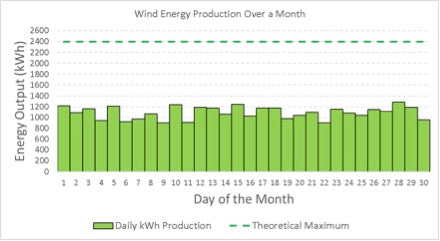Wind Power: Importance of the Capacity Factor
Wind Power: Importance of the Capacity Factor
Renewable energy sources such as wind and solar power depend on variable inputs, which means they can’t always produce power at full nameplate capacity. However, projects become more lucrative as they approach their ideal maximum output, and a detailed feasibility study can be key in making accurate predictions.
If a 100-kilowatt wind power system was capable of operating at full output for an entire month (720 hours), the total energy produced would be 72,000 kilowatt-hours. However, this ideal behavior does not occur in actual projects because wind speed is subject to variability.
The capacity factor is a convenient way to represent how close a wind turbine operates to ideal output, and it is calculated as follows:

Alternatively, the formula can be represented in the following way:

In most cases, the timeframe for analysis is either a 30-day month (720 hours) or a year (8760 hours). If a 100-kW wind power system produces 32,670 kWh in a month, the capacity factor is the following:

If the production profile was measured over the entire month, the result obtained would be similar to the following graph:

A capacity factor of 45.38% may seem small when compared with the values achieved with other power generation technologies. For example, there are coal power plants that operate above 90% capacity factor. However, wind power operates with a free input and with zero carbon emissions. Comparing power plants based on capacity factor is only valid if they use the same generation technology.
Importance of Measurements
Measurements play a key role in any renewable energy project, since they provide the basis for feasibility studies. Of course, measurements are only as reliable as the device used to obtain them.
Estimating the Capacity Factor of a Wind Turbine
In order to estimate the capacity factor of a wind power system, two key pieces of information are necessary:
- A detailed wind profile for the prospective project site.
- Power curves from the wind turbine manufacturer.
Wind turbine power curves are provided, so you don’t have to worry about that part. However, the wind profile must be obtained on-site because every project has unique conditions. In many places, it is possible to get wind maps from airports and weather institutions, but they can’t provide the accuracy of an on-site wind study.
WindLogger is an affordable weather monitoring solution, which can be equipped with a wind vane to measure the prevailing wind direction at a specific site, as well as dual anemometers to analyze winds speed patters with a high degree of precision. WindLogger technology is also equipped with:
- GSM communication, which grants access to information from any place and at any time.
- Cloud data storage, which ensures that gathered information is backed up safely at a data center away from the project site.
Once the wind profile is available, the information gathered can be used along with turbine manufacturer power curves to carry out an accurate estimate of energy production.
Benefits of a Feasibility Study
Knowing the expected energy output and capacity factor of a wind power system allows a reliable financial analysis of the project to be carried out:
- For a given installed capacity, a wind power system will tend to have the same upfront cost regardless of site conditions.
- The expected energy output is critical in determining whether a project is viable or not. For instance, a wind power system operating at 40% capacity factor will duplicate the return on investment compared to another one at 20%. If multiple sites are being considered, a feasibility study can help determine the best option.
- The expected energy production can be represented as cash savings, just by multiplying it with the cost of energy plus any incentives locally available.
If you have questions like the following, a feasibility study can help you find the answers:
- What return on investment and payback period can I expect?
- If I purchase the wind power system with a loan, will it be able to pay for its own cost?
- By how much will my yearly energy expenses be reduced?
WindLogger can help you answer these questions, by offering a reliable and rugged weather monitoring tool that allows precise site assessments. Don’t miss the opportunity to maximize the benefits from your wind power investment.
اترك تعليق
سيتم مراجعة التعليقات قبل عرضها.






